高中英语必修三第三单元教案教学内容
人教版高一英语必修3Unit 3教学设计教案
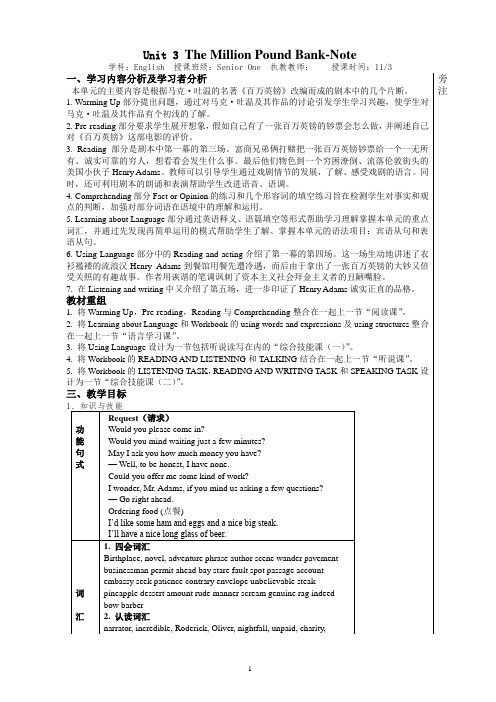
Unit 3 The Million Pound Bank-Note学科:English 授课班级:Senior One 执教教师:授课时间:11/3一、学习内容分析及学习者分析本单元的主要内容是根据马克·吐温的名著《百万英镑》改编而成的剧本中的几个片断。
1. Warming Up部分提出问题,通过对马克·吐温及其作品的讨论引发学生学习兴趣,使学生对马克·吐温及其作品有个初浅的了解。
2. Pre-reading部分要求学生展开想象,假如自己有了一张百万英镑的钞票会怎么做,并阐述自己对《百万英镑》这部电影的评价。
3. Reading部分是剧本中第一幕的第三场。
富商兄弟俩打赌把一张百万英镑钞票给一个一无所有、诚实可靠的穷人,想看看会发生什么事。
最后他们物色到一个穷困潦倒、流落伦敦街头的美国小伙子Henry Adams。
教师可以引导学生通过戏剧情节的发展,了解、感受戏剧的语言。
同时,还可利用剧本的朗诵和表演帮助学生改进语音、语调。
4. Comprehending部分Fact or Opinion的练习和几个形容词的填空练习旨在检测学生对事实和观点的判断,加强对部分词语在语境中的理解和运用。
5. Learning about Language部分通过英语释义、语篇填空等形式帮助学习理解掌握本单元的重点词汇,并通过先发现再简单运用的模式帮助学生了解、掌握本单元的语法项目:宾语从句和表语从句。
6. Using Language部分中的Reading and acting介绍了第一幕的第四场。
这一场生动地讲述了衣衫褴褛的流浪汉Henry Adams到餐馆用餐先遭冷遇,而后由于拿出了一张百万英镑的大钞又倍受关照的有趣故事。
作者用诙谐的笔调讽刺了资本主义社会拜金主义者的丑陋嘴脸。
7. 在Listening and writing中又介绍了第五场,进一步印证了Henry Adams诚实正直的品格。
人教版高中英语必修三Unit3TheMillionPoundBankNoteWriting教案
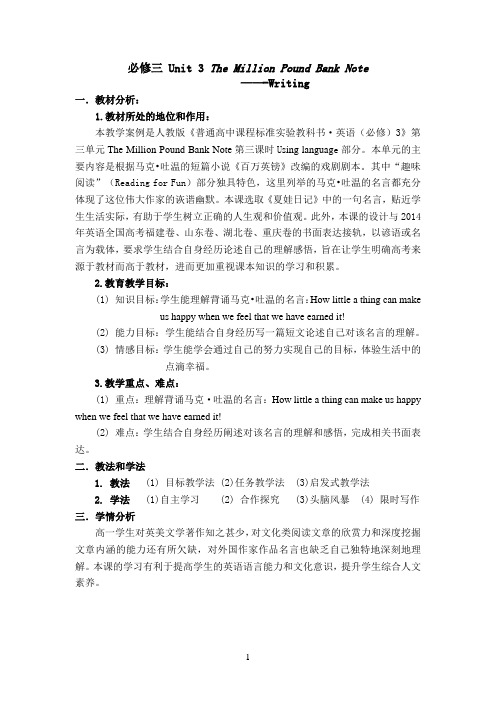
必修三 Unit 3 The Million Pound Bank Note——-Writing一.教材分析:1.教材所处的地位和作用:本教学案例是人教版《普通高中课程标准实验教科书·英语(必修)3》第三单元The Million Pound Bank Note第三课时U sing languag e部分。
本单元的主要内容是根据马克•吐温的短篇小说《百万英镑》改编的戏剧剧本。
其中“趣味阅读”(Reading for Fun)部分独具特色,这里列举的马克•吐温的名言都充分体现了这位伟大作家的诙谐幽默。
本课选取《夏娃日记》中的一句名言,贴近学生生活实际,有助于学生树立正确的人生观和价值观。
此外,本课的设计与2014年英语全国高考福建卷、山东卷、湖北卷、重庆卷的书面表达接轨,以谚语或名言为载体,要求学生结合自身经历论述自己的理解感悟,旨在让学生明确高考来源于教材而高于教材,进而更加重视课本知识的学习和积累。
2.教育教学目标:(1) 知识目标:学生能理解背诵马克•吐温的名言:How little a thing can makeus happy when we feel that we have earned it!(2) 能力目标:学生能结合自身经历写一篇短文论述自己对该名言的理解。
(3) 情感目标:学生能学会通过自己的努力实现自己的目标,体验生活中的点滴幸福。
3.教学重点、难点:(1) 重点:理解背诵马克·吐温的名言:How little a thing can make us happy when we feel that we have earned it!(2) 难点:学生结合自身经历阐述对该名言的理解和感悟,完成相关书面表达。
二.教法和学法1. 教法(1) 目标教学法 (2)任务教学法 (3)启发式教学法2. 学法(1)自主学习 (2) 合作探究 (3)头脑风暴 (4) 限时写作三.学情分析高一学生对英美文学著作知之甚少,对文化类阅读文章的欣赏力和深度挖掘文章内涵的能力还有所欠缺,对外国作家作品名言也缺乏自己独特地深刻地理解。
人教版必修三unit3单元整体教学
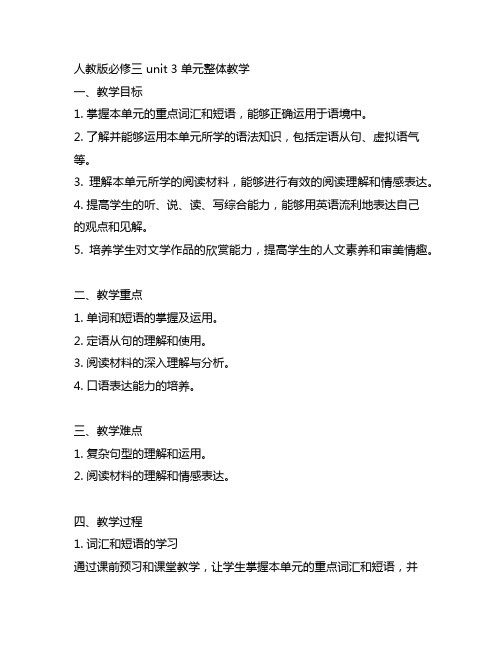
人教版必修三 unit 3 单元整体教学一、教学目标1. 掌握本单元的重点词汇和短语,能够正确运用于语境中。
2. 了解并能够运用本单元所学的语法知识,包括定语从句、虚拟语气等。
3. 理解本单元所学的阅读材料,能够进行有效的阅读理解和情感表达。
4. 提高学生的听、说、读、写综合能力,能够用英语流利地表达自己的观点和见解。
5. 培养学生对文学作品的欣赏能力,提高学生的人文素养和审美情趣。
二、教学重点1. 单词和短语的掌握及运用。
2. 定语从句的理解和使用。
3. 阅读材料的深入理解与分析。
4. 口语表达能力的培养。
三、教学难点1. 复杂句型的理解和运用。
2. 阅读材料的理解和情感表达。
四、教学过程1. 词汇和短语的学习通过课前预习和课堂教学,让学生掌握本单元的重点词汇和短语,并能够正确运用于日常交流和写作表达中。
2. 语法知识的讲解重点讲解定语从句和虚拟语气等语法知识,并通过大量的练习让学生掌握并能够正确应用于实际语境中。
3. 阅读材料的学习与理解导入本单元的阅读材料,引导学生深入理解其中的文学意义和情感表达,并进行讨论和写作练习,提高学生的表达能力和文学鉴赏能力。
4. 口语表达能力的培养通过小组讨论、角色扮演等形式,培养学生的口语表达能力,让学生在实际交流中能够用英语流利地表达自己的见解和情感。
五、教学手段1. PPT课件2. 多媒体设备3. 教材配套音频4. 课堂练习题册六、教学评价通过课堂教学、作业练习、阅读分析及口语表达等方式对学生的学习情况进行全方位的评价,及时发现问题并给予指导,进一步提高学生的学习效果和素质。
七、教学反思在教学的过程中,要根据学生的实际水平和兴趣特点,合理安排教学内容和方法,结合学生的学习风格,激发学生的学习动力,培养学生的学习兴趣,让学生在轻松愉快的氛围中提高自身的英语水平,实现教学目标的有效达成。
八、课外拓展在整体教学结束后,可以引导学生进行课外拓展,包括文学作品赏析、英语报刊阅读、影视欣赏等形式,进一步提高学生的英语综合能力和文学素养。
高中英语必修三第三单元教案DescribingPeople’sAppearance

高中英语必修三第三单元教案DescribingPeople’sAppearance。
在教材中,描述人的外貌特征的方法主要有三种:使用形容词、使用名词短语、使用动词。
其中,使用形容词是描述人外貌特征的最常用方式。
教学目标1.掌握描述人的外貌特征的基本词汇。
2.培养学生使用形容词,名词短语和动词来描述人的外貌特征的能力。
3.提高学生描述人的外貌特征时的语言表达能力和准确度。
教学重点1.掌握描述人的外貌特征的基本词汇。
2.培养学生使用形容词,名词短语和动词来描述人的外貌特征的能力。
教学难点1.提高学生描述人的外貌特征时的语言表达能力和准确度。
2.让学生了解不同文化之间的外貌审美差异。
教学过程Step1. Warm-up让学生看一段视频,随后让学生用英文描述视频中人物的具体外貌特征,这是为了让学生得到一个学习记忆的刺激和启发。
Step2. Introducing vocabulary在这个环节,老师会让学生学习有关描述人的外貌特征的基本词汇,包括人的身高,眼睛的颜色,头发的颜色和长度等。
老师可以利用图片和短语来帮助学生学习相关的词汇。
Step3. Exercise为了让学生巩固刚刚学习过的词汇,老师可以设计一些练习题,包括填空,选择和阅读理解等。
Step4. Introducing grammar老师会让学生学习描述人的外貌特征的语法结构,包括使用形容词、名词短语和动词来描述人的外貌特征。
老师可以通过具体的例子来帮助学生更好地理解这些语法结构。
Step5. Exercise让学生完成有关描述人的外貌特征的语法练习,增强学生的语言表达能力。
Step6. Cross-cultural communication通过比较不同国家之间的外貌审美差异,让学生了解不同文化之间的差异,并让学生明白外貌并不是评价一个人的唯一标准。
Step7. Exercise设计练习题,让学生运用所学知识来描述不同国家人的外貌特征,并帮助学生理解和尊重不同文化之间的差异。
人教版英语必修三Unit 3(Reading)教案

The Million Pound Bank Note – Reading 教案Teaching Contents: Unit 3 The Million Pound Bank Note (Reading)(高中英语必修三第三单元17页The Million Pound Bank Note课文阅读部分)Teaching Objectives:●Knowledge Objectives1. To learn some new words and expressions.2. To ensure the students have a full understanding of this passage.3. To let the students know more background information about the play and Mark Twain.●Ability Objectives1. To improve the students’ reading ability through reading activities.2. To get the students to learn different reading skills.●Moral Objectives1. To arouse the students’ interest in foreign literature.2. To cultivate the students’ ability and awareness of cooperation.Teaching Important Points:1. To make the students have a full understanding of this passage.2. To improve the students’ reading ability through reading activities.Teaching Difficult Points:1 .To help the students understand the passage better.2. To improve the students’ reading ability in different ways.Teaching Methods:1. Task-based method2. Discussing method2. Fast reading3. Careful readingTeaching Aids:1. Multi-media facilities2. A blackboard3. Textbook and Exercise booksTeaching procedures:Step I Greeting and leading in (6 minutes)1. Greeting2. Watch a short video about Mark Twain. (Ask the students to pay attention to the details about Mark Twain.)3. Tell something about Mark Twain.Step II Fast Reading (10 minutes)1.Ask the students to read the first paragraph quickly and find the time and the maincharacters of this passage.2.Ask the students to scan the whole passage and choose the best answers.3.Teacher guide the students how to find the answers.StepⅢCareful Reading (20 minutes)1. Ask the students to read the whole passage carefully and try to answer the given questions.2. Ask the students to read the passage and put the following statements in the correct order according to the development of the story. (Ask the students to discuss it with their desk mates) 同步训练第38页3.Ask the students to read the passage and try to write down the main idea of the passage. (Fill in the blanks)StepⅣ Summary (8 minutes)1.Ask the students to finish the exercise in the exercise book. (一线精练第17页)2.Teacher gives the answers and correct.Step ⅤHomework (1 minute)1. Think about what kind of person Henry was? Give at least two reasons.2. Can you guess the following story? Write at least 5 sentences.。
高中英语人教版必修3Unit3全单元教案设计

高中英语人教版必修3Unit3全单元教案设计Unit 3The Million Pound Bank Note单元规划类别课程标准要求掌握的项目话题Forms of literature and art: short story and drama; how to act out a play词汇birthplacen.出生地; 故乡Embassy n. 大使馆; 大使及其官员phrasen.短语; 词组; 惯用语Seek vt. & vi. 寻找; 探索; 寻求adventure n. 奇遇; 冒险patience n. 耐性; 忍耐novel n.小说; 长篇故事adj. 新奇的; 异常的contrary n. 反面; 对立面adj. 相反的;相违的authorn.著者; 作家Envelope n. 信封scenen.(戏剧)一场; 现场; 场面;景色Permit vt. & vi. 许可; 允许; 准许n. 通行证; 许可证; 执照wander vi. 漫游; 漫步; 漂泊steak n. 肉块; 鱼排; 牛排pavement n. 人行道pineapple n. 菠萝businessman n. 商人dessert n. 餐后甜点unbelievable adj. 难以置信的amount n. 数量aheadad v. 在前; 向前; 提前rude adj. 粗鲁的; 无礼的bayn.海湾mannern.礼貌; 举止; 方式stare vi. 凝视; 盯着看scream vi. 尖声叫n. 尖叫声; 喊叫声fault n. 过错; 缺点; 故障genuine adj. 真的; 真诚的bow vi. & n. 鞠躬; 弯腰rag n. 破布; 碎布passage n. 船费; 通道; (一)段indeed adv. 真正地; 确实; 实在account vt. & vi. 认为; 说明; 总计有n. 说明; 理由; 计算;账目spot vt. 发现; 认出n. 斑点; 污点;地点短语bring up抚养; 培养; 教育; 提出in rags衣衫褴褛go ahead 前进; (用于祈使句)可以; 往下说as for关于; 至于by accident偶然; 无意中; 不小心do with对待; 处理; 处置stare at盯着看; 凝视make a bet打赌account for导致; 做出解释be lost迷路; 倾心于某事on the contrary与此相反; 正相反permit sb. to do sth. 准许某人做某事take a chance冒风险; 碰运气in a. . . manner以……的举止(态度)重要句型1. Young man, would you step inside a moment, please? (request)2. I wonder, Mr. Adams, if you’d mind us asking a few questions. (I wonder if. . . )3. . . . I found myself carried out to sea by a strong wind. (find+O. +O. C. )4. And it was the ship that brought you to England. (it is/was. . . that. . . )5. The fact is that I earned my passage by working as an unpaid hand. . . (noun clause as thepredicative)6. You mustn’t think we don’t care about you. (double negative)7. That’s why we’ve given you the letter. (noun clause asthe predicative)8. Well, why don’t you explain what this is all about?(suggestion; noun clause as the object)功能 1. RequestWould you please come in?Could you offer me some kind of work?Would you mind waiting just a few minutes?I wonder, Mr. Adams, if you mind us asking a few questions? May I ask you how much money you have?—Well, to be honest, I have none.—Go right ahead.2. Ordering foodI’d like some ham and eggs and a nice big steak.I’ll have a nice long glass of beer.3. Shopping语法 1. Noun clauses as the objectI can’t say that I have any plans.. . . and he does not know what he should do.。
人教课标版高中英语必修三 Unit3 Reading for structure 教案-新版

Unit3 Reading for structure教学设计1. Teaching Analysis 教情分析1.1 Teaching objectives-教学目标In and after this period, students will be able to1.1.1 Discover the rules of predictive and object clauses in a clear way1.1.2 Practice and apply the rules in exercises connected with the play.1.1.3 Know how to use subject-verb agreement correctly in speaking and writing.1.2 Important &difficult teaching points-教学重难点1.2.1Important teaching points-教学重点Clarify the grammar rules and understand them.1.2.2Difficult teaching points-教学难点Help Ss understand and use the rules correctly.2. Student analysis学情分析2.1 Fundamental state基本情况本单元语法为宾语从句和表语从句的学习和使用。
二者属于名词性从句范畴,其中宾语从句学生在初中已经重点学习过,而表语从句则只是在平时练习中有过无意识的碰面,因此在教学中可以先从宾语入手,逐渐加深,然后拓展迁移到表语从句的学习。
本册书随后还要名词性从句中的同位语从句,主语从句等,因此学习好两个从句能为学生学习名词性从句打好关键的基础。
两个从句在平时的学习中出现频率高,使用范围广,但是学生经常出现错误。
(完整版)人教版高中英语必修三第三单元教案
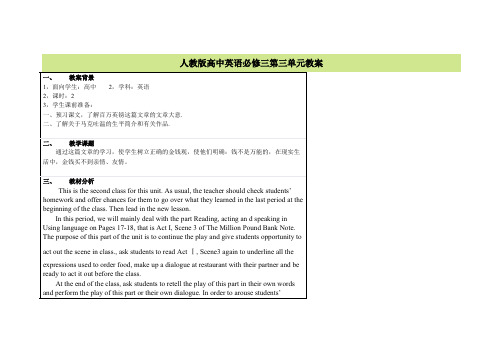
interest, the teacher can hold a competition among them.教学重点1. Develop students’ reading and speaking skills.2. Let students read and act the play.3. Have students learn to use the expressions t o order food.教学难点1. Enable students to learn to use reading strategies such as skimming, scanning, and so on.2. Get students to act the play.3. Have students make a dialogue at the restaurant.三维目标知识与技能目标1. Get students to learn some useful new words and expressions in this part.2. Get students to read the play.3. Let students learn the expressions of ordering food.过程与方法目标1. Develop students’ reading skills and enable them to learn how to use different reading strategies to read different reading materials.2. Enable student s to understand and act out the play.3. Have students learn how to use the expressions to order food.情感态度与价值观目标1. Stimulate students’ interests of learning English by reading and acting this play.2. Develop students’ sense of group cooperation and teamwork.四、教学方法Problems probing method. Work in groupsMake a quiz for the students to find out how much they already know about Mark Twain, Ask students to answer questions by groups. The questions are as follows:1.What was the real name of Mark Twain?2.What was his job?3.Can you name one of his famous novels?五、教学过程→Step 1 Revision1. Check the homework exercises.2. Ask some students to read the words of U3.→Step 2 Warming up1. Ask students to make a list of all the changes that Henry has made to his life.2. Have them in pairs discuss what difference they think this will make to the way people treat him and report their ideas to the class.3. Learn more about Mark Twain. Then list some popular novels such as The Adventures of TomSawyer, The Prince and the Pauper. [百度知道]→Step 3 Brief introduction of The million pound note[百度知道]Step 4 listen to the tape1. Ask the all turn to Page 17. We are going to listen to ActⅠ, Scene 3.2. Let them listen carefully and write down the main idea.3. Play the tape again to check and have the correct answers.→Step 5 Reading and speaking task1. Ask students to discuss the following questions in pairs.1) Where did Henry come from?2) Why was Henry in London?3) What happened to Henry?→Step5 See the movie [百度知道]Let a group retell the story and start a role play.→Step 6 Think overDo you know the exchange rate between pound and RMB?[百度知道]→Step 6 Homework1. Finish the Workbook exercises.2. Review the contents of the unit and complete Summing Up on Page 24.六、教学反思这篇课文很有挖掘、开发的价值,通过the waiter和老板的语言、动作、神态等描写,细致刻画出两个市井人物的见钱眼开、惟利是图的丑恶嘴脸。
高中英语必修三unit 3 diverse cultures全单元(共四部分)教学设计教案
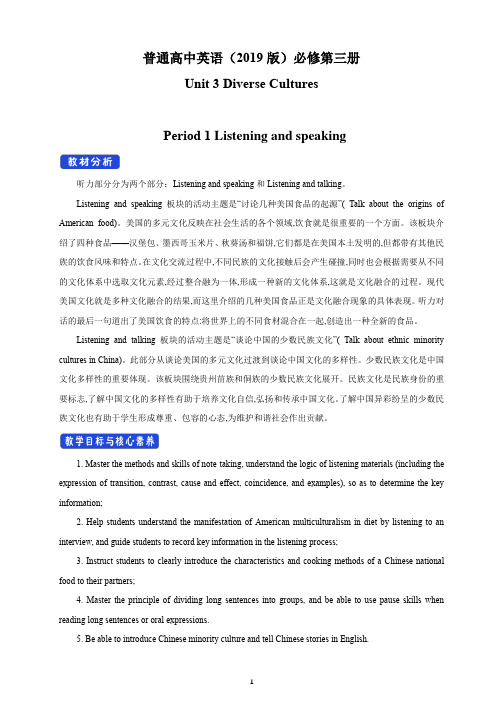
普通高中英语(2019版)必修第三册Unit 3 Diverse CulturesPeriod 1 Listening and speaking听力部分分为两个部分:Listening and speaking和Listening and talking。
Listening and speaking板块的活动主题是“讨论几种美国食品的起源”( Talk about the origins of American food)。
美国的多元文化反映在社会生活的各个领域,饮食就是很重要的一个方面。
该板块介绍了四种食品——汉堡包、墨西哥玉米片、秋葵汤和福饼,它们都是在美国本土发明的,但都带有其他民族的饮食风味和特点。
在文化交流过程中,不同民族的文化接触后会产生碰撞,同时也会根据需要从不同的文化体系中选取文化元素,经过整合融为一体,形成一种新的文化体系,这就是文化融合的过程。
现代美国文化就是多种文化融合的结果,而这里介绍的几种美国食品正是文化融合现象的具体表现。
听力对话的最后一句道出了美国饮食的特点:将世界上的不同食材混合在一起,创造出一种全新的食品。
Listening and talking板块的活动主题是“谈论中国的少数民族文化”( Talk about ethnic minority cultures in China)。
此部分从谈论美国的多元文化过渡到谈论中国文化的多样性。
少数民族文化是中国文化多样性的重要体现。
该板块围绕贵州苗族和侗族的少数民族文化展开。
民族文化是民族身份的重要标志,了解中国文化的多样性有助于培养文化自信,弘扬和传承中国文化。
了解中国异彩纷呈的少数民族文化也有助于学生形成尊重、包容的心态,为维护和谐社会作出贡献。
1. Master the methods and skills of note-taking, understand the logic of listening materials (including the expression of transition, contrast, cause and effect, coincidence, and examples), so as to determine the key information;2. Help students understand the manifestation of American multiculturalism in diet by listening to an interview, and guide students to record key information in the listening process;3. Instruct students to clearly introduce the characteristics and cooking methods of a Chinese national food to their partners;4. Master the principle of dividing long sentences into groups, and be able to use pause skills when reading long sentences or oral expressions.5. Be able to introduce Chinese minority culture and tell Chinese stories in English.Importance:1. Help students understand the manifestation of American multiculturalism in diet by listening to an interview, and guide students to record key information in the listening process;2. Instruct the students to clearly introduce the characteristics and cooking methods of a Chinese national food to their partners.3. Be able to introduce Chinese minority culture and tell Chinese stories in English.Difficulties:1. Clearly introduce the characteristics and cooking methods of a Chinese national food to the partners;2. Master the principle of dividing long sentences into groups, and be able to use pause skills reasonably when reading long sentences or oral expressions.3. Be able to introduce Chinese minority culture and tell Chinese stories in English.1. Review the vocabulary about food and understand the characteristics of Chinese traditional food culture;2. Read this section in advance, review the vocabulary of American food, and understand the characteristics of American food culture.Step 1 Lead-in1.The teacher presents a news report to help students understand the meaning of diverse in the title.Overseas Students Experience Diverse Cultures at Shandong University Shandong University in Jinan, East China's Shandong Province unveiled its I8th International Cultural Festival at its central campus on April 26, offering locals a chance to experience unique cultures from 25 countries around the world.Overseas students from Russia, France, Thailand, Afghanistan, Italy, Uganda, and Laos wore traditional costumes as they showcased food,dances,handcrafts,and souvenirs from their home countries.Since 2001, the international cultural event has evolved into an important channel the university to promote its campus culture featuring understanding, inclusiveness.for openness, and progress.2.According to the above context, the teacher guides the students to discuss the meaning of diversecultures, and then asks them to try to explain the meaning of unit title "diverse cultures" in their own language.Students can explain it this way :It means the coexistence of many different types of cultures in a specific region or in the world as a whole. Each culture has its distinct features and each other’s differences are respected.Step 2 Watching and talkingActivity 11.Teachers makes full use of pictures to find the breakthrough of unit teaching.The following questionscan guide students to observe the details in the picture, so as to understand the cultural information and its connotation carried by the picture, and establish a connection with the unit theme.What can you see in the photo?(buildings, lamp post, lanterns.) Do you find the place familiar?What are some words on the buildings?Why are there both Chinese and English shop signs?Where do you think this photo was taken?What day you think such a place is like?Do you think this is a typical place to show cultural diversity? Why?2.Appreciate famous quotes.The teacher asks the following questions to help students understand thequotation and relate the unit topic:Can you paraphrase the quote in your own words?Can you give some examples to demonstrate the diversity of people in world?Can you think of some examples to show diverse cultures in the world?3.Ask the students to quickly review the listening, speaking, reading and writing tasks listed in theopening page. Then ask the students to close their books and answer the positive questions.What are some topics you will read about/ listen to?What are some topics you will talk/write about?Which part do you think will interest you?What do you expect to learn from this unit?Step 3 ListeningActivity 21.Ask the students to look at the four pictures in activity 1.2.Students were asked to match the picture to the following description and then to try to match it to thename of the food.Picture A: small pieces of thin crisp chips served with beans, cheese, spices, etc (nachos).Picture B: a crisp hollow cookie containing a piece of paper with a short message on it (fortune cookie).Picture C: a thick seafood soup,a spicy stew(gumbo).Picture D: a sandwich containing cooked meat and some other vegetables in a bread roll (hamburger).Activity 31.The teacher plays the recording for the first time and asks the students to verify whether the matching food names in activity 1 are correct.2. The teacher plays the recording for the second time. The teacher arranges the following questions in advance to guide the students to get the key information and grasp the general meaning of the listening dialogue.Where does this conversation take place? How do you know?Who are the speakers?What is the topic of the conversation?What is Steve Fox’s opinion about American food?How many examples does Steve Fox give to support his opinion? What are they?Activity 41.Look at the five sentences in activity 3.Let's listen to the tape for the third time.The teacher first lets the student understand the problem, then completes the listening task, in this way the student listens with the purpose, is helpful to develop the selective attention strategy.2.Ask the students to browse the listening task of activity 4. First, try to fill in the information in the form from memory.Next, the teacher plays the tape again and asks the students to fill out the rest of the information and reminds them to use the shorthand strategy.If students can fill out most of the information, teachers can ask them to fill in more information on the form as they listen.When the students were finished, they were asked to use the information in the table to organize the language and verbally describe each food.3.Listen to the tape again and ask the students to complete the following sentences in the listening text.He’s here to talk about cultural influences on American food.You mean there was a mixing of cultures? Food from overseas changed when it arrived in the States.And there are many more examples of mixed-culture dishes.So they’re like a mix of the Chinese, American, and Japanese cultures.It was invented in New Orleans over 200 years ago, and mixes French, African, Native American, and Spanish cooking.So it's the food of many different cultures, all in one dish?American cooking often mixes things from around the world to make something completely new. Step 4 SpeakingActivity 51.Teachers can use courseware to show pictures and definitions of potluck to introduce this interestingcultural phenomenon to students.Such as:A potluck dinner is a meal to which each guest brings a dish of food prepared by the person, tobe shared among the group.2.Next, the teacher can ask the following questions to start thinking:How do you think potluck dinners show diverse cultures in the world?What food would you bring to the party if you were invited?Why do you choose this food?3.Teachers create a situation and ask students to create a dialogue in pairs. One student ACTS as a guestinvited to a potluck party and the other gives advice as a friend.Each group is asked to have a conversation about the origin, preparation and characteristics of a food according to the three questions in activity 5.Students can also add cultural information about the history and legends of the food.After the students have finished the drill, the teacher may ask several groups of students to present to the class. Step 5 PronunciationActivity 61. Understand the spoken text.Read the passage silently and answer the following questions:What is this text about?What did you learn about them from the text?2.Mark the pauses in the passage. Then ask one of the students to read to the class.In combination withthe student's problems in pausing, help students understand the role of pausing: first, pausing allows us to take a breath in time, so that we won't be so tired in the process of speaking;Secondly, proper pauses allow us to better grasp the rhythm of speaking and express ourselves.3. The teacher plays the recording, guides the students to make necessary modifications, and summarizesthe common positions of pauses.4. Listen to the tape again and ask the students to follow the tape.5. Let the students read the passage in pairs. Help each other to improve the accuracy and fluency ofreading.Finally, please have a few students present to the class.Step 6 ListeningActivity 71.Ask students to focus on the three pictures in activity 1 and try to describe each picture, including:Photo 1: Where do you think these men are from? What are they doing? What are they holding in their hands? What is the instrument like? What arc their clothes like?Photo 2: Where do you think the girls are from? What are they doing? What are their clothes like?What are they wearing on their heads?Photo 3: Can you find in the photo which village it is? What time is it in the photo? What is the village like?Based on the description of the students, the teacher skillfully penetrated the key words in the listening dialogue, such as silver, accessory, minority, musical instrument, perform, etc.2.It's about the ethnic minority cultures of the Miao and Dong people in China. It's about the ethnicminority cultures of the Miao and Dong people in China.3.Let the students focus on the Miao and Dong ethnic groups, share their understanding of the twoethnic minorities, fully activate the students' background knowledge, and prepare for the following listening activities.Step 7 Listening comprehensionActivity 81.Grasp the main idea of the listening.Listen to the tape and answer the following questions:Who are the two speakers in the listening? What is their relationship?What is the main idea of the first part of the listening? How about the second part?plete the passage.Ask the students to quickly review the summaries of the two listening materialsin activity 2. Then play the recording for the second time.Ask them to complete the passage and fill in the blanks.3.Play the recording again and ask the students to use the structure diagram to comb the informationstructure in the listening.(While listening, take notes. Capture key information quickly and accurately.) Step 8 TalkingActivity 91.Focus on the listening text.Listen to the students and listen to the tape. Let them understand theattitudes of Wu Yue and Justin in the conversation.How does Wu Y ue feel about Chinese minority cultures?What does Justin think of the Miao and Dong cultures?How do you know that?2.learn functional items that express concerns.Ask students to focus on the expressions listed in activity.3.And try to analyze the meaning they convey, including praise (Super!).Agree (Exactly!)"(You'rekidding.!)Tell me more about it. Tell me more about it.For example, "Yeah Sure." "Definitely!""Certainly!" "No kidding!" "No wonder!" and so on.4.Ask the students to have conversations in small groups, acting as Jsim and his friends.Justin shares histravels in Guizhou with friends and his thoughts;Justin's friends should give appropriate feedback, express their interest in relevant information, and ask for information when necessary.In order to enrich the dialogue, teachers can expand and supplement the introduction of Miao, dong, Lusheng and Dong Dage.After the group practice, the teacher can choose several groups of students to show, and let the rest of the students listen carefully, after listening to the best performance of the group, and give at least two reasons.Step 9 Homework1)Independently complete the exercises in the guide plan;.2)Remember the new words and learn the usages of them.1、通过本节内容学习,学生能否清晰地向同伴介绍一种中国民族食品的特点和烹饪方法;2、通过本节内容学习,学生能否通过听一段访谈对话来了解美国多元文化在饮食方面的体现,并指导学生在听力过程中记录关键信息;3、通过本节内容学习,学生能否掌握听力理训练中的听力策略。
英语必修三unit3 教案
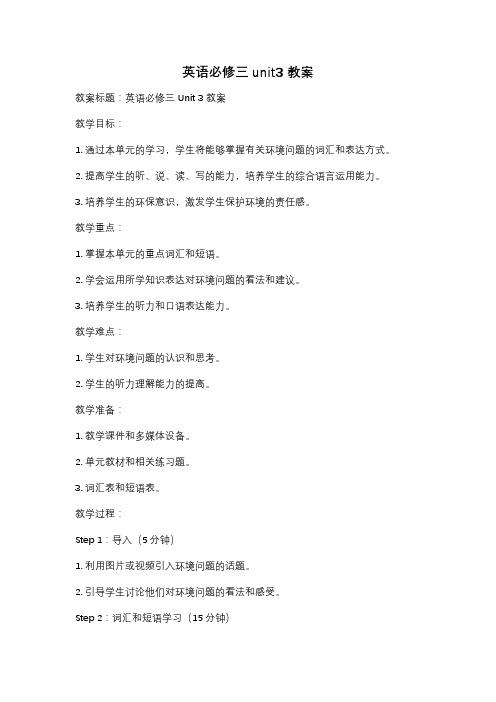
英语必修三unit3 教案教案标题:英语必修三 Unit 3 教案教学目标:1. 通过本单元的学习,学生将能够掌握有关环境问题的词汇和表达方式。
2. 提高学生的听、说、读、写的能力,培养学生的综合语言运用能力。
3. 培养学生的环保意识,激发学生保护环境的责任感。
教学重点:1. 掌握本单元的重点词汇和短语。
2. 学会运用所学知识表达对环境问题的看法和建议。
3. 培养学生的听力和口语表达能力。
教学难点:1. 学生对环境问题的认识和思考。
2. 学生的听力理解能力的提高。
教学准备:1. 教学课件和多媒体设备。
2. 单元教材和相关练习题。
3. 词汇表和短语表。
教学过程:Step 1:导入(5分钟)1. 利用图片或视频引入环境问题的话题。
2. 引导学生讨论他们对环境问题的看法和感受。
Step 2:词汇和短语学习(15分钟)1. 教师通过展示词汇和短语的图片或示意图,呈现新词汇和短语。
2. 学生跟读并重复词汇和短语,教师进行发音指导。
3. 教师带领学生进行词汇和短语的记忆和巩固练习,如词汇卡片配对、填空等。
Step 3:听力训练(20分钟)1. 教师播放与环境问题相关的听力材料,要求学生听取关键信息。
2. 学生进行听力理解练习,如选择题、填空等。
3. 教师进行听力答案讲解和反馈。
Step 4:口语表达(15分钟)1. 学生分组进行小组讨论,讨论有关环境问题的话题,如"Should plastic bagsbe banned?"。
2. 学生展示自己的观点和想法,并进行互动交流。
3. 教师对学生的口语表达进行评价和指导。
Step 5:阅读理解(15分钟)1. 学生阅读与环境问题相关的文章或短文。
2. 学生回答与文章内容相关的问题,进行阅读理解练习。
3. 教师进行答案讲解和解释。
Step 6:写作训练(15分钟)1. 学生根据所学知识和讨论内容,撰写一篇关于环境问题的短文。
2. 学生相互交换作文,并进行修改和改进。
必修三英语unit3教案
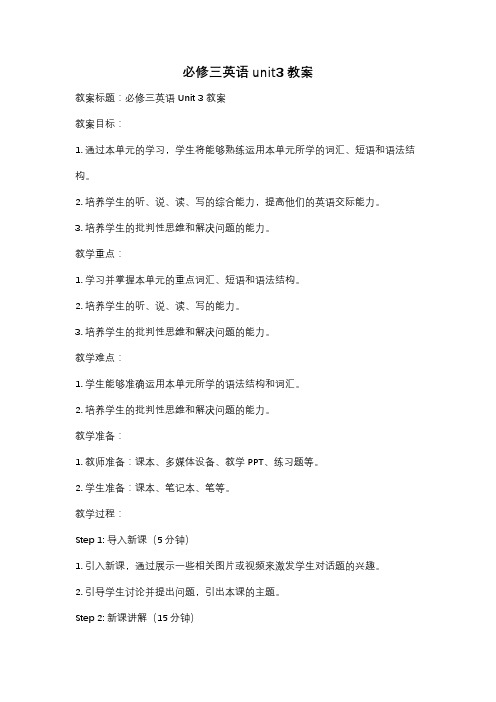
必修三英语unit3教案教案标题:必修三英语 Unit 3 教案教案目标:1. 通过本单元的学习,学生将能够熟练运用本单元所学的词汇、短语和语法结构。
2. 培养学生的听、说、读、写的综合能力,提高他们的英语交际能力。
3. 培养学生的批判性思维和解决问题的能力。
教学重点:1. 学习并掌握本单元的重点词汇、短语和语法结构。
2. 培养学生的听、说、读、写的能力。
3. 培养学生的批判性思维和解决问题的能力。
教学难点:1. 学生能够准确运用本单元所学的语法结构和词汇。
2. 培养学生的批判性思维和解决问题的能力。
教学准备:1. 教师准备:课本、多媒体设备、教学PPT、练习题等。
2. 学生准备:课本、笔记本、笔等。
教学过程:Step 1: 导入新课(5分钟)1. 引入新课,通过展示一些相关图片或视频来激发学生对话题的兴趣。
2. 引导学生讨论并提出问题,引出本课的主题。
Step 2: 新课讲解(15分钟)1. 教师通过PPT或黑板等方式,讲解本单元的重点词汇、短语和语法结构。
2. 结合例句和实际情境,帮助学生理解和记忆新知识。
Step 3: 听说训练(20分钟)1. 播放相关录音或视频材料,让学生进行听力训练。
2. 设计一些与课文内容相关的口语练习,让学生进行对话练习。
Step 4: 阅读训练(20分钟)1. 学生独立阅读课文,理解文章的大意和细节。
2. 学生进行小组讨论,分享自己的理解和观点。
3. 教师组织全班讨论,引导学生深入思考课文中的问题和主题。
Step 5: 写作训练(15分钟)1. 学生根据课文内容,完成相关写作任务,如写一篇短文、写一封信等。
2. 学生互相交流和修改自己的作文,提高写作质量。
Step 6: 巩固练习(15分钟)1. 教师设计一些练习题,让学生巩固所学的语法和词汇。
2. 学生独立完成练习,并相互检查答案。
Step 7: 课堂总结(5分钟)1. 教师对本节课的内容进行总结,并强调重点和难点。
高中英语外研版必修三Module 3 The Violence of Nature教案

Module3 The Violence of Nature一、教材分析1. 话题:本阅读课是围绕整个单元的中心话题“The Violence of Nature”而展开的。
2. 内容:本文描述了龙卷风和飓风这两大自然灾害爆发的时间、地点、情形、经过、最后的结果、造成的危害、人员财产损失的情况。
最后以Charles Coghlan 的经历讲述了一个与飓风有关的离奇故事。
3. 目标:①扫清课文中出现的生词障碍;②理解课文内容,理清篇章的组织脉络;③引导学生学会根据主题理解文章细节的能力和根据关键词复述课文的能力。
二、教学实践1.教学步骤step 1. Warming up1)以introduction 部分的图片入手,引出本课关于自然灾害的词汇,然后用brainstorm的形式让学生快速想出相关词汇。
2) Discussion: Have you ever experienced such an event or read a news story about one of the events? Can you describe it? 让全班学生两人一组互相讲述自己的经历,有利于激发学生说的兴趣,在学生的相互交流中培养起发现问题和解决问题的能力,然后让个别学生起来展示,培养学生的自信心和表达能力,同时也自然过渡到了本节主题。
Step 2. Reading1)Skimming 快速阅读全文,理清大意;2)Scanning ①细读文章,回答part2 的问题。
提问学生展示答案,针对有问题的答案让学生讨论后再做纠正,培养其自主解决问题的能力。
②然后再从definition,speed,phenomena and worst event 几个方面比较tornado and hurricane的不同之处,旨在培养学生理解细节和提取信息的能力。
3)Exercise 进一步加强学生对文章的理解。
Step 3. Post-readingRetell the passage.组织学生重述课文内容来加强学生对全文的理解,同时也锻炼了学生的口语能力。
必修三英语unit3说课稿
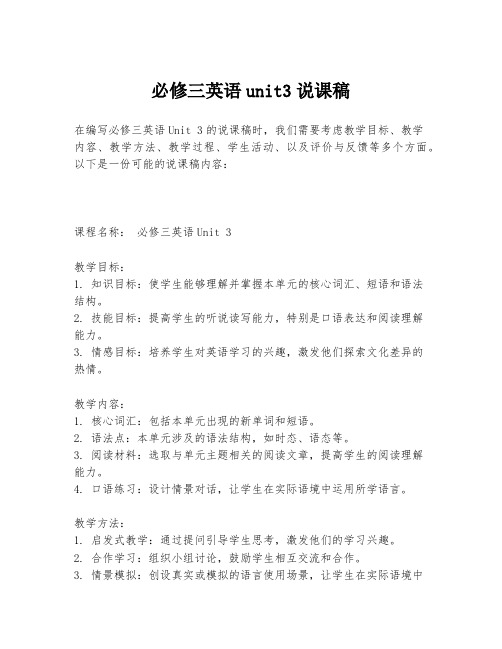
必修三英语unit3说课稿在编写必修三英语Unit 3的说课稿时,我们需要考虑教学目标、教学内容、教学方法、教学过程、学生活动、以及评价与反馈等多个方面。
以下是一份可能的说课稿内容:课程名称:必修三英语Unit 3教学目标:1. 知识目标:使学生能够理解并掌握本单元的核心词汇、短语和语法结构。
2. 技能目标:提高学生的听说读写能力,特别是口语表达和阅读理解能力。
3. 情感目标:培养学生对英语学习的兴趣,激发他们探索文化差异的热情。
教学内容:1. 核心词汇:包括本单元出现的新单词和短语。
2. 语法点:本单元涉及的语法结构,如时态、语态等。
3. 阅读材料:选取与单元主题相关的阅读文章,提高学生的阅读理解能力。
4. 口语练习:设计情景对话,让学生在实际语境中运用所学语言。
教学方法:1. 启发式教学:通过提问引导学生思考,激发他们的学习兴趣。
2. 合作学习:组织小组讨论,鼓励学生相互交流和合作。
3. 情景模拟:创设真实或模拟的语言使用场景,让学生在实际语境中练习语言。
教学过程:1. 导入(Lead-in):通过图片、视频或问题引入单元主题,激发学生的好奇心。
2. 新课呈现(Presentation):介绍新词汇和语法点,通过例句和解释帮助学生理解。
3. 练习(Practice):设计形式多样的练习,如填空、改错、翻译等,巩固学生对新知识的理解。
4. 应用(Application):通过角色扮演、情景对话等活动,让学生在实际语境中运用所学知识。
5. 总结(Summary):回顾本节课的重点内容,确保学生对知识点有清晰的认识。
学生活动:1. 个人作业:完成课后练习,加深对知识点的理解和记忆。
2. 小组合作:参与小组讨论,共同完成指定任务,提高团队协作能力。
3. 展示(Presentation):在班级前展示小组讨论的成果,锻炼口语表达能力。
评价与反馈:1. 形成性评价:通过课堂观察、小组讨论和个人作业等方式,了解学生的学习进度和理解程度。
英语必修三unit3教案

英语必修三unit3教案教案标题:Exploring Culture through Language - Unit 3: English Compulsory 3 教学目标:1. 通过本单元的学习,学生将能够了解和探索不同的文化背景对语言的影响。
2. 培养学生的跨文化交流能力,提高他们的跨文化意识和理解力。
3. 提高学生的听说读写能力,并能够在真实情境中运用所学知识。
教学重点:1. 了解不同文化对语言的影响。
2. 学习并运用相关词汇和表达方式。
3. 提高听说读写能力。
教学难点:1. 学生对于不同文化背景下的语言差异的理解和接受。
2. 学生的跨文化交流能力培养。
教学准备:1. PowerPoint演示文稿。
2. 学生教材和相关学习资料。
3. 录音设备和音频材料。
4. 文化相关图片和视频素材。
教学过程:一、导入(5分钟)1. 通过展示一些国际文化图片或视频,引发学生对跨文化主题的兴趣。
2. 提出问题:你认为不同文化背景对语言有什么影响?二、新课讲解(15分钟)1. 介绍本单元的主题和学习目标。
2. 分享一些不同文化背景下的语言差异的例子,并引导学生思考和讨论。
3. 通过PPT和多媒体素材,讲解本单元的重点词汇和表达方式。
三、听说训练(20分钟)1. 听力练习:播放相关录音材料,要求学生听取关键信息并回答问题。
2. 口语练习:以小组为单位,让学生讨论并展示不同文化背景下的语言差异,鼓励他们使用所学词汇和表达方式。
四、阅读训练(15分钟)1. 学生阅读相关阅读材料,并回答问题。
2. 分组讨论阅读材料中提到的文化差异,并分享自己的观点和体验。
五、写作训练(20分钟)1. 学生根据所学内容,撰写一篇短文,描述他们对不同文化背景下的语言差异的理解和感受。
2. 鼓励学生使用所学词汇和表达方式,同时提供写作指导和反馈。
六、拓展活动(10分钟)1. 分组展示学生的写作成果,并进行同学间的互动和讨论。
2. 观看相关文化视频,进一步拓宽学生的跨文化视野。
人教版高中英语必修 第三册Unit 3 教案

M3 U3 Reading and Thinking教学设计&学案一、文本解读该阅读文本是一则旅行日记。
在日记中,中国学生Li Lan记录了自己的加州之行,并主要介绍了在旧金山一天的行程和所见所闻所感,从最初对地震后重建的旧金山的建筑产生兴趣到探索这个城市,慢慢体会到多元文化对它的不同方面的影响。
旅行日记与日记相似,首行是日期,正文即主体部分,常以第一人称讲述在旅行地参观的景点、参与的活动和旅行的感受。
本篇旅行日记结构清晰,作者按照时间顺序叙述了自己再旧金山一天的行程。
第一段描述了作者对旧金山的第一印象。
第二、三、四分别叙述了作者上午、下午、傍晚在旧金山的所做所见所闻所感。
第五段叙述了第二天的行程安排。
贯穿该旅行日记的主线是旧金山的多元文化,作者在一天的旅行过程中体验和体会到了多元文化在这个城市的各个方面的体现。
在阅读策略方面,学生通过寻读快速浏览文本,找到一些特殊信息,如时间、地点等;通过细读文本,提取、梳理和加工作者活动、感想、印象等,并用结构图呈现出来(Classify and organize information by drawing a diagram)。
二、课时目标通过本课时的学习,学生能够:1. 运用寻读策略,寻找、提取旅行时间、地点、图片,分析语篇类型。
2. 运用提取、梳理、加工、归纳等策略,寻找和梳理旅行活动,归纳和推断作者旅行的感想,并用结构图加以呈现,积累相关主题语言。
3.讨论旧金山多元文化的特点和成因。
4. 讨论多元文化对生活的影响。
三、教学重难点引导学生理解旧金山的多元文化特征和影响;指导学生使用结构图分类和整理文本信息,从而把握文章的结构和作者的写作逻辑。
四、设计思路教师首先以一则San Francisco的介绍视频为导入,要求学生找出视频中涉及的地点,随后分享want to know,激发学生学习兴趣,激活学生已有的背景知识和主题词汇;讨论diverse culture的意思,引出单元主题;引导学生通过寻读定位旅行地点、时间、图片,分析旅行日记的语篇特点;然后引导学生通过细读、提取、梳理、加工信息等阅读策略,持续默读,聚焦文本主要内容,分组完成作者旅行见闻和感想的结构图;然后引导学生再次阅读文本,概括旧金山多元文化的特点,推断、归纳多元文化对人们生活的影响;最后引导学生以V-log的形式介绍这个多元文化的为特点的城市,整合输出语言。
必修三unit3 教案
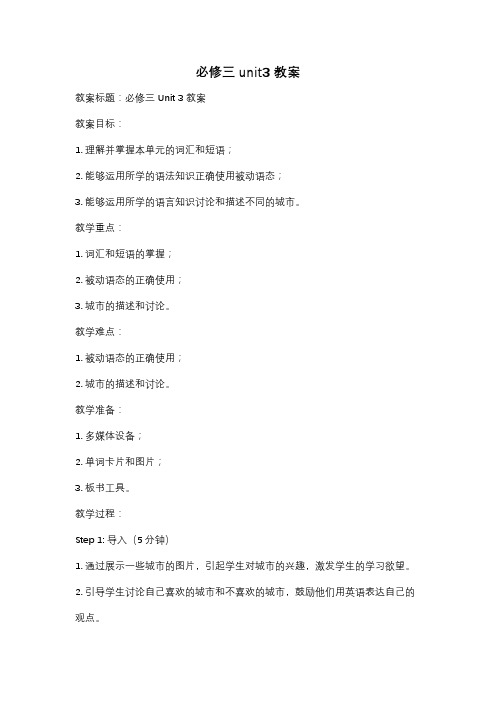
必修三unit3 教案教案标题:必修三 Unit 3 教案教案目标:1. 理解并掌握本单元的词汇和短语;2. 能够运用所学的语法知识正确使用被动语态;3. 能够运用所学的语言知识讨论和描述不同的城市。
教学重点:1. 词汇和短语的掌握;2. 被动语态的正确使用;3. 城市的描述和讨论。
教学难点:1. 被动语态的正确使用;2. 城市的描述和讨论。
教学准备:1. 多媒体设备;2. 单词卡片和图片;3. 板书工具。
教学过程:Step 1: 导入(5分钟)1. 通过展示一些城市的图片,引起学生对城市的兴趣,激发学生的学习欲望。
2. 引导学生讨论自己喜欢的城市和不喜欢的城市,鼓励他们用英语表达自己的观点。
Step 2: 词汇和短语学习(15分钟)1. 分发单词卡片,让学生阅读并尝试发音。
2. 通过图片或实物展示,解释单词的意思。
3. 引导学生进行词汇和短语的搭配练习,例如:“traffic jam”,“skyscraper”等。
Step 3: 语法学习(20分钟)1. 通过多媒体展示被动语态的用法和结构,并解释其基本规则。
2. 给学生提供一些例句,让他们尝试将主动语态转换为被动语态。
3. 给学生一些练习题,让他们巩固被动语态的用法。
Step 4: 阅读和讨论(20分钟)1. 分发阅读材料,让学生阅读有关不同城市的文章。
2. 引导学生进行小组讨论,让他们分享自己对不同城市的看法和观点。
3. 鼓励学生使用被动语态和所学的词汇和短语来描述和讨论城市。
Step 5: 总结和作业布置(5分钟)1. 总结本节课所学的内容,强调被动语态的正确使用和城市描述的技巧。
2. 布置作业:要求学生写一篇关于自己所在城市的短文,使用被动语态和所学的词汇和短语进行描述。
教学反思:通过本节课的教学,学生能够掌握本单元的词汇和短语,理解并正确使用被动语态,能够用英语进行城市的描述和讨论。
同时,通过小组讨论和写作作业,学生的口语和写作能力也得到了提高。
高一英语教案:必修三Unit3教案

A Teaching PlanUnit 3 The Million Pound Bank-NoteWarming up and ReadingTeaching aims and demands:*Knowledge aims:1. To learn some words and expressions.2. To make sure the students have a full understanding of the text.3. To guide the students to have a discussion about the characters in the text .4. To get the students to know more about a play by reading and acting.*Ability aims:1. To cultivate the students’ reading ability.2. To cultivate the students’ oral English skills and related knowledg e about a play by discussion and acting.*Moral aims:1. To enable the students to know more about the quality of capitalist society and to educate them to love our country more.2. To educate the students to work together to finish some tasks.3. To arous e the students’ interest in learning English through various activities in class.Teaching important points:1. To make the students have a full understanding of the text.2. To make the students know more about a play by discussion and acting. Teaching difficult points:1. To improve the students’ reading ability.2. To enable the students to voice their opinions freely.Teaching materials:1. The videos of the film clips.2. Some related pictures.3. A tape of the text.Teaching aids:1. Multi-media facilities.2. A recorder.Teaching methods:1. Asking-and-answering method.2. Discussing method.The title : Unit 3 The Million Pound Bank-NoteSome words and phrases: a large amount of ; millionaire ; make a bet (on sth.) ; land (v.); bay ; jealous ; character ; “fact” and “opinion”附: 马克• 吐温的格言警句1. The man who does not read books has no advantage over the man that cannot read them.2. Always tell the truth; then you don’t have to remember anything.3. When people do not respect us we are sharply offended; yet deep down in his private heart no man much respects himself.4. Good breeding consists in concealing how much we think of ourselves and how little we think of the other person.。
- 1、下载文档前请自行甄别文档内容的完整性,平台不提供额外的编辑、内容补充、找答案等附加服务。
- 2、"仅部分预览"的文档,不可在线预览部分如存在完整性等问题,可反馈申请退款(可完整预览的文档不适用该条件!)。
- 3、如文档侵犯您的权益,请联系客服反馈,我们会尽快为您处理(人工客服工作时间:9:00-18:30)。
(3,3)重点词汇1. n. 赌;打赌v. 打赌;赌钱[典例]1). He often bets a 1ot of money on horses.2). I bet that it will rain tomorrow.[重点用法]bet on为某事打赌make a bet on 为某事打赌win/lose a bet 打赌赢/输了[练习] 按要求翻译。
1).We ______ ______ ______ ______ (打赌)the outcome of the next horse race.2).他把所有的钱都用在赌马上。
_______________________________________________________________________________2.n. 缺点;错误,过错;故障vt.挑剔,指责faulty adj.有缺点的;不完善的faultless adj.不可挑剔的[典例]No one could fault his performance.①I wonder how they got lost and whose fault it was.②Somehow,people seem to think it’s my fault for letting him in.③He is such a man who is always finding fault with other people.[重点用法]It’ s one’ s fault 是某人的过错find fault in看出……的缺点,找出……的毛病find fault with对……不满,挑剔[练习] 翻译或填空。
她总是找我的茬儿。
_______________________________________________________________________________ 从你的文章里我找不到错误,它完美无瑕。
I can’t ________________________your paper.It is perfect.3.vt. 发现;认出n. 污点;斑点;地点spotless adj. 没有斑点的,干净的[典例]1). This is the very spot where he was murdered.2). She was wearing a white skirt with red spots.①I had just sat down to work when I spotted something moving on the wall.②He spotted a serious mistake in the accounts.③I easily spotted him in the crowd because he was very tall.④I was on the spot when the accident happened.[重点用法]spot sb. doing sth. 看到某人正在做某事on the spot = on the scene到(在)现场;当场[练习] 用spot的短语或其适当形式填空。
1). The police ______ him driving a stolen car.2). The police were ______ ______ ______ within a few minutes.3). He keeps his house _______.完成句子When the man was trying to break into the bank,he_____________________(当场被警察抓住).4. n. 通道;(书、讲话、音乐等的)一段,一节;经过,通过,消逝;旅费[典例]1). They were denied passage through the occupied territory.2). He worked his passage to Australia.[重点用法]with the passage of time 随着时间的推移[练习] 按要求翻译或填空。
1). Her confidence grew _______ _______ (随着时间的推移).2). Several passages _______ (介词) the book were printed in a national newspaper before it waspublished.5.n. 说明;理由;计算,账目vi.&vt. 认为;说明;解释总;计有[典例]1). I’ m going to the bank to open a new account.2). Bad weather accounted for the long delay.①How do you account for your absence from school yesterday?②On no account must employers make personal telephone calls from the office.③His exam results were not very good,but we must take his long illness into account.④The train was delayed on account of snow.⑤He paid the money into his account.[重点用法]account for导致;做出解释;总计有 on account of = because of 因为open an account在银行开个户头keep an account of记录,记载take sth. into account/consideration考虑到某事[练习] 用account的短语填空。
1). The League members in our school ______ ______ half of the students.2). She couldn’ t _______ _______ her foolish mistake.完成句子缺钱是她辍学的原因。
____________________________her not continuing her studies.Since we are not wealthy now,we’d better take our daily expenses into________.A.thought B.account C.position D.effect6. vt.&vi. (sought, sought) 寻找;探索;寻求[典例]1). You must seek permission from the manager.2).They are seeking to mislead us.[重点用法]seek (for/after) sth./sb. 寻找某人/某物seek to do sth. 试图做某事seek happiness/comfort/wealth/success追求幸福﹑安逸﹑财富、成功[练习] 用所给词的适当形式填空。
1). I think it’ s time we ________ (seek) legal advice.2). They are seeking ________ (change) the rules.7. n.数(量);总额vi.(to)合计;接近[典例]1). Can you really afford this amount?2). The cost amounted to 250 pound.[重点用法]a (large/small) amount of + n.[u] + v. (单数) (large/small) amounts of + n.[u] + v. (复数)in (large/small) amounts [作状语]大(少)量地amount to... 共达……,合计……[练习] 用amount的短语翻译或所给词的适当形式填空。
1). Duting the earthquake, a large amount of damage _______ (do) in a very short time.2). Large amounts of money _______ (spend) rebuilding the temple.3). At that time, mall amounts of land _______ (use) for keeping animals.4). The total cost of repairs _______ _______ (总计) $100.8. [bau] vi.&vt. 鞠躬;弯腰[bəu] n.[c] 弓,蝴蝶结;鞠躬[典例]1). We all bowed to the Queen.2). His back was bowed with age.[重点用法]bow to/before sb. 向某人鞠躬bow to sth. 向……低头;接受某事[练习] 用bow的短语或其适当形式填空。
1). The boss ______ ______ the demands of the workers.2). The cast ______ as the audience applauded.9.n.(戏剧)一场;现场;场面;景色;(电影,电视的)一个镜头;(事件发生的)地点典例:①Reporters were soon on the scene after the accident.②The happy scene of children playing in the garden disappeared,and it was quiet again.③The students were able to go behind the scenes to see how programmes are made.④They rushed to the scene of the traffic accident.重点用法:on the scene在现场;当场appear/come on the scene出场;登场behind the scenes在幕后;暗中the scene of the accident事故现场辨析:scene,scenery与view(1)scene指都市景观或室内陈设,还可指舞台场面或部分布景,是可数名词。
